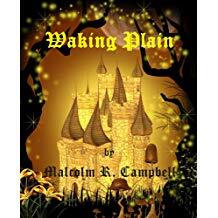Malcolm R. Campbell's Blog, page 28
July 1, 2023
I hope people still read Doctorow’s novel ‘Ragtime’
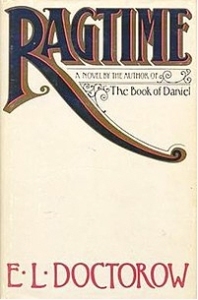 “Edgar Lawrence Doctorow (January 6, 1931 – July 21, 2015) was an American novelist, editor, and professor, best known for his works of historical fiction.
“Edgar Lawrence Doctorow (January 6, 1931 – July 21, 2015) was an American novelist, editor, and professor, best known for his works of historical fiction.
“He wrote twelve novels, three volumes of short fiction and a stage drama, including the award-winning novels Ragtime (1975), Billy Bathgate (1989), and The March (2005). These, like many of his other works, placed fictional characters in recognizable historical contexts, with known historical figures, and often used different narrative styles. His stories were recognized for their originality and versatility, and Doctorow was praised for his audacity and imagination.” – Wikipedia
Doctorow’s novels, especially Ragtime and The March rank high on my list of great storytelling and great writing. Those who aren’t among his fans dislike his mix of historical and fictional characters, calling it “audacity.” The movie version of Ragtime, Cagney’s last role after a twenty-year hiatus from films, is well worth seeing for the ambiance and the actors (many new) who had difficult parts to play. Among these was Howard E. Rollins, Jr. as Coalhouse Walker, Jr. (“I read music so good, white folks think I’m fakin’ it.”)
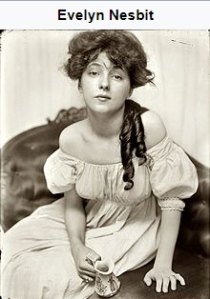 Nesbit
NesbitAs historical fiction, Ragtime captures the flavor of the world of ragtime that basically ran from the 1890s to the 1910s along with now-iconic events such as the murder of architect Stanford White in 1906 by Harry Thaw for White’s rape of fashion model Evelyn Nesbit (and ultimately Thaw’s wife). Thaw was acquitted for the reason of insanity.
The primary story is about the character Coalhouse Walker a professional musician who plays ragtime music on the piano. As Wikipedia puts it, “Things go well until he is humiliated by a racist fire crew, led by Will Conklin, who vandalize his Model T Ford. He begins a pursuit of redress by legal action but discovers he cannot hope to win because of the inherent prejudice of the system. Sarah is killed in an attempt to aid him, and Coalhouse uses the money he was saving for their wedding to pay for an extravagant funeral.”
The mix of historical that figures into the sad story of Coalhouse Walker is one of the novel’s triumphs, I think, and may obscure (for some readers) what is fact and what is fiction. Some critics hate this sort of mix while I applaud it.
One comes away from both the novel and the movie with an appreciation for the times and the times’ abuses and systemic injustice.
–Malcolm
June 30, 2023
Okay, I’ve ordered the latest installment in Diana Gabaldon’s ‘Outlander Series’
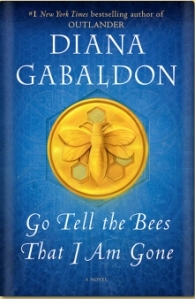 Go Tell the Bees That I Am Gone was released in 2021 and now that the prices have come down, I can afford to order the book that (due to its length) costs more than my house when it’s new.
Go Tell the Bees That I Am Gone was released in 2021 and now that the prices have come down, I can afford to order the book that (due to its length) costs more than my house when it’s new.
I “knew” Diana online on the old CompuServe Litforum when Outlander, the first book in the series, was released in 1991. She was very helpful to those of us who were early on in our writing careers. She wrote a blurb for my novel The Sun Singer, and my wife and I met her once when she was in Atlanta for a book signing. The series, of which “Bees” is the 9th book, has been airing on Starz. I watched a few of the early episodes but took issue with the production and didn’t stay with it. However, I did approve of the series’ use of Scots Gaelic.
On her website, Diana writes, “Where did the title for this book come from? Talking to your bees is a very old Celtic custom (known in other parts of Europe, too) that made it to the Appalachians. You always tell the bees when someone is born, dies, comes or goes—because if you don’t keep them informed, they’ll fly away.”
The first three books in the series came out fairly close together, so I hoped that would continue. Then the books got longer, took more time to write, and have been released slowly. So I debated whether I want to stay with the series inasmuch as each installment represents quite an investment in time. But, once I get into the story, I won’t leave it,
From the Publisher
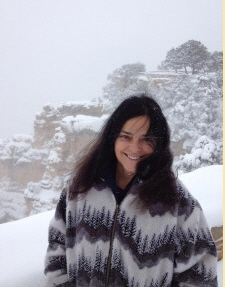 War leaves nobody alone. Neither the past, the present, nor the future offers true safety, and the only refuge is what you can protect: your family, your friends, your home.
War leaves nobody alone. Neither the past, the present, nor the future offers true safety, and the only refuge is what you can protect: your family, your friends, your home.
Jamie Fraser and Claire Randall were torn apart by the Jacobite Rising in 1746, and it took them twenty years of loss and heartbreak to find each other again. Now it’s 1779, and Claire and Jamie are finally reunited with their daughter, Brianna, her husband, Roger, and their children, and are rebuilding their home on Fraser’s Ridge—a fortress that may shelter them against the winds of war as well as weather.
But tensions in the Colonies are great: Battles rage from New York to Georgia and, even in the mountains of the backcountry, feelings run hot enough to boil Hell’s teakettle. Jamie knows that loyalties among his tenants are split and it won’t be long before the war is on his doorstep.
Brianna and Roger have their own worry: that the dangers that provoked their escape from the twentieth century might catch up to them. Sometimes they question whether risking the perils of the 1700s—among them disease, starvation, and an impending war—was indeed the safer choice for their family.
Not so far away, young William Ransom is coming to terms with the mysteries of his identity, his future, and the family he’s never known. His erstwhile father, Lord John Grey, has reconciliations to make and dangers to meet on his son’s behalf and on his own, and far to the north, Young Ian Murray fights his own battle between past and future, and the two women he’s loved.
Meanwhile, the Revolutionary War creeps ever closer to Fraser’s Ridge. Jamie sharpens his sword, while Claire whets her surgeon’s blade: It is a time for steel.
While I’m reading, I know I will feel it’s time well spent.
–Malcolm
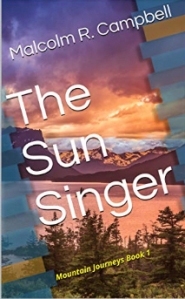 “The Sun Singer is gloriously convoluted, with threads that turn on themselves and lyrical prose on which you can float down the mysterious, sun-shaded channels of this charmingly liquid story” – Diana Gabaldon
“The Sun Singer is gloriously convoluted, with threads that turn on themselves and lyrical prose on which you can float down the mysterious, sun-shaded channels of this charmingly liquid story” – Diana Gabaldon
June 28, 2023
Changing our world without knowing it
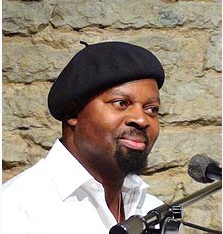 “Beware of the stories you read or tell; subtly, at night, beneath the waters of consciousness, they are altering your world.” — Ben Okri
“Beware of the stories you read or tell; subtly, at night, beneath the waters of consciousness, they are altering your world.” — Ben Okri
Ben Okri, who won the 1991 Booker Prize for this novel The Famished Road, is quoted often and in many places when it comes to words of wisdom about storytelling.
When we think of storytelling, whether from oral traditions of centuries past or the novels we peruse on Amazon, we tend to think of stories as tales intended to be read or otherwise passed along to others. What we overlook, out of habit, are the stories we tell ourselves.
Even things said over and over in jest/sarcasm such as “My feet our killing me.” I suggest that if you say that or think that often enough, your feet will ultimately kill you because the idea has become part of our world view about yourself.
Those who teach meditation often ask us to get rid of the on-going interior monologue that runs like an endless podcast inside our heads. First, it’s uncensored and often negative in some way. Second, it fills our thoughts with dribble, shutting down our ability to hear the stories we need to hear. Third, that monlogue is a barrier to the songs of the universe, knowledge we might get through intuition or other communication with higher powers and totem animals.
And then I guess we might say that if the only person we’re listening to is that podcast from ourselves, we won’t hear much else. What a pity, in a world built on stories, thousands of voices are trying to get our attention.
–Malcolm
June 27, 2023
‘Tatterdemalion,’ by Sylvia Linsteadt
Oops, I meant to say something about this wonderful book when it came out two years ago. The book is well-written and beautifully illustrated by the widely-known faerie world artist Rima Staines.
From the Publisher
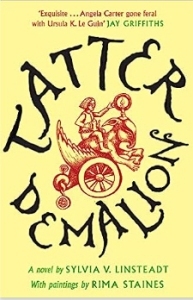 “In a ruined world, what survives are the stories we tell Poppy, who speaks the languages of wild things, travels east to the mountains with the wheeled and elephantine beast Lyoobov. He’s seeking answers to the mysteries of his birth, and the origins of the fallen world in which he lives. Up in the glacial peaks, among a strange, mountainous people, a Juniper Tree takes Poppy deep into her roots and shows him the true stories of the people who made his world, people he thought were only myths. Their tales span centuries, from three hundred years in the future all the way back to our present day. It is through this feral but redemptive folklore that Poppy begins to understand the story of his own past and his place in the present. Tatterdemalion is a stunning collaboration between writer Sylvia V. Linsteadt and artist Rima Staines, featuring the fourteen original paintings that inspired the narrative.”
“In a ruined world, what survives are the stories we tell Poppy, who speaks the languages of wild things, travels east to the mountains with the wheeled and elephantine beast Lyoobov. He’s seeking answers to the mysteries of his birth, and the origins of the fallen world in which he lives. Up in the glacial peaks, among a strange, mountainous people, a Juniper Tree takes Poppy deep into her roots and shows him the true stories of the people who made his world, people he thought were only myths. Their tales span centuries, from three hundred years in the future all the way back to our present day. It is through this feral but redemptive folklore that Poppy begins to understand the story of his own past and his place in the present. Tatterdemalion is a stunning collaboration between writer Sylvia V. Linsteadt and artist Rima Staines, featuring the fourteen original paintings that inspired the narrative.”
 “Sylvia Victor Linsteadt is an author, scholar of ancient history, and certified wildlife tracker. She studied Literary Arts at Brown University, graduating with Honors in 2011.
“Sylvia Victor Linsteadt is an author, scholar of ancient history, and certified wildlife tracker. She studied Literary Arts at Brown University, graduating with Honors in 2011.
“Her work—both fiction and non-fiction—is rooted in myth, ecology, feminism & bioregionalism, and is devoted to broadening our human stories to include the voices of the living land.”
“She is the author of the short story collection Our Lady of the Dark Country, two novels for young readers, The Wild Folk (Nominated for the CILIP Carnegie Medal in 2019) and The Wild Folk Rising, and the post-apocalyptic folktale cycle Tatterdemalion with painter Rima Staines.”
To learn more about folklore/fae authors, artists, and illustrators, I recommend the blog Myth and Moor. While the blog has been on hiatus (but becoming active again), you will find faerie resources and authors in the right-hand column.
Malcolm R. Campbell is the author of the upside-down faerie tale, “Waking Plain.”
June 26, 2023
Keep Notes at All Times. You Never Know When You’ll Need Them
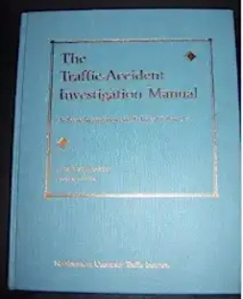 When I worked as a course developer at the Northwestern University Center for Public Safety (then called The Traffic Institute) in the 1970s, I had no idea anything I did there would ever be relevant to a future novel. The center’s focus is police management and also accident investigation. While I worked more closely with the police management and supervision courses, I also wrote exams and handouts for the accident investigation curriculum.
When I worked as a course developer at the Northwestern University Center for Public Safety (then called The Traffic Institute) in the 1970s, I had no idea anything I did there would ever be relevant to a future novel. The center’s focus is police management and also accident investigation. While I worked more closely with the police management and supervision courses, I also wrote exams and handouts for the accident investigation curriculum.
The center’s courses were based in large measure on the work of J. Stannard Baker whom I consider the father of modern accident investigation. If the name sounds familiar it’s because his father was Ray Stannard Baker (aka David Grayson), a Pulitzer Prize-winning muckraking journalist in the late 1800s. While I had studied the muckrakers in college, I never asked Mr. Baker about his family because I was sure he was tired of questions about them.
I was rather in awe of him and his accomplishments in accident investigation, one of which was detailing a way to tell whether a car’s headlights were on or off at the time of an accident. I found him to be a low-key individual who was easy for a young course developer to work with. He treated me as an equal, a status I didn’t think I really deserved.
I remember the courses and, in fact, have a copy of one of his books that will very much help me write competent accident investigation scenes in my novel in progress.
I didn’t include an accident investigation in the novel because I worked with Mr. Baker, but because it was central to the story’s plot. Old memories and old employment just happened to be a research gift.
–Malcolm
Malcolm R. Campbell is the author of contemporary fantasy, paranormal, and magical realism short stories and novels.
June 25, 2023
This and That for Sunday June 25
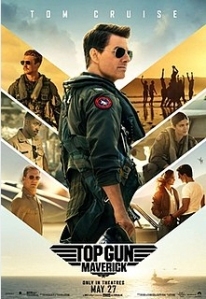 Some say this movie was better than the original. Possibly so, for it provided a lot of action, an imposible mission, and an over-the-top look at sort of real navial aviation. While it didn’t make me miss my days aboard an aircraft carrier, I’ll give it five stars and call it a “hoot,” and kudos to Tom Cruise for his acting. The movie was filmed on the U.S.S. Abraham Lincoln and the navy earned a pack of doughfor sequences involving F/A-18 fighters. Without providing a real spoiler, I can mention there was an F-14 in the movie; the one used was in a museum since the navy doesn’t have any and borrowing from Iran seemed like a catastrophee waiting to happen.
Some say this movie was better than the original. Possibly so, for it provided a lot of action, an imposible mission, and an over-the-top look at sort of real navial aviation. While it didn’t make me miss my days aboard an aircraft carrier, I’ll give it five stars and call it a “hoot,” and kudos to Tom Cruise for his acting. The movie was filmed on the U.S.S. Abraham Lincoln and the navy earned a pack of doughfor sequences involving F/A-18 fighters. Without providing a real spoiler, I can mention there was an F-14 in the movie; the one used was in a museum since the navy doesn’t have any and borrowing from Iran seemed like a catastrophee waiting to happen.
 I like the series of Cross novels by James Patterson, but took a detour to read the novel he co-authored with Dolly Parton, Run Rose Run. The book reads well and is a special treat for those who want to know how a potential country singer breaks into the business, especially one with bad guys chasing her.For those of you keeping score, I have chili simering in the Dutch over for tonight’s supper.
I like the series of Cross novels by James Patterson, but took a detour to read the novel he co-authored with Dolly Parton, Run Rose Run. The book reads well and is a special treat for those who want to know how a potential country singer breaks into the business, especially one with bad guys chasing her.For those of you keeping score, I have chili simering in the Dutch over for tonight’s supper.  Here’s an interesting article from Literary Hub: “Against the Cynicism Cycle: Why TV Could Do with Less Moral Grayness.” Noah Ciubotaru writes, “We’ve celebrated moral grayness, deemed it to be indicative of clever writing, a sign of art’s ability to twist and stump our moral intuitions. But maybe our praise has been misplaced; maybe grayness has become an empty affectation, doing nothing for us, and asking nothing of us but to drift through unfeeling stories.” I tend to agree with him.I think I mentioned a couple of weeks ago that my GP said my symptons indicated a prospective bleeding ulcer and that he was referring me to a specialist. So far, no word from a specialist. I remember the old days whe one’s GP treated the whole shebang rather than sending you off to somebody with higher fees.I
Here’s an interesting article from Literary Hub: “Against the Cynicism Cycle: Why TV Could Do with Less Moral Grayness.” Noah Ciubotaru writes, “We’ve celebrated moral grayness, deemed it to be indicative of clever writing, a sign of art’s ability to twist and stump our moral intuitions. But maybe our praise has been misplaced; maybe grayness has become an empty affectation, doing nothing for us, and asking nothing of us but to drift through unfeeling stories.” I tend to agree with him.I think I mentioned a couple of weeks ago that my GP said my symptons indicated a prospective bleeding ulcer and that he was referring me to a specialist. So far, no word from a specialist. I remember the old days whe one’s GP treated the whole shebang rather than sending you off to somebody with higher fees.I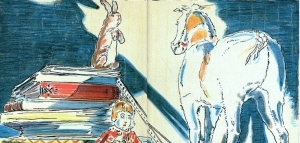 read the Velveteen Rabbit years ago. So I was drawn to this story: “More Than A Children’s Story: The Velveteen Rabbit At 100.” No, I did not read it on the day it came out. I’m not that old. Lisa Rowe Fraustino writes, “Margery Williams was born in London on July 22, 1881, and died September 4, 1944, in New York City. Though she published twenty-seven books, including five translations of works from French and Norwegian, and though she won the John Newbery Honor Medal for her novel Winterbound (1936) in 1937, she is primarily known today as the author of The Velveteen Rabbit.”
read the Velveteen Rabbit years ago. So I was drawn to this story: “More Than A Children’s Story: The Velveteen Rabbit At 100.” No, I did not read it on the day it came out. I’m not that old. Lisa Rowe Fraustino writes, “Margery Williams was born in London on July 22, 1881, and died September 4, 1944, in New York City. Though she published twenty-seven books, including five translations of works from French and Norwegian, and though she won the John Newbery Honor Medal for her novel Winterbound (1936) in 1937, she is primarily known today as the author of The Velveteen Rabbit.”–Malcolm
June 24, 2023
‘The Civilian Conservation Corps Cookbook,’ by Amy Bizzarri
One bonus of learning what the CCC fed its volunteers is, as Arcadia Publishing notes, this book released in May “features over 80 historic recipes adapted for today’s home kitchen.” The Texas Highways Magazine review notes that those recipes include pineapple fritters, snowflake potatoes, sloppy joes, and wacky cake. What’s not to like?
From the Publisher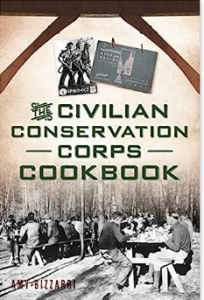 “The Civilian Conservation Corps was a voluntary government work relief program that offered nearly 3 million unemployed, unmarried men the job of restoring and conserving America’s public lands, forests, and parks. The wages weren’t the only draw–the program also threw in three square meals a day served in the camp mess hall. The Civilian Conservation Corps Cookbook features the recipes that sustained not only the CCC during the Great Depression but also our grandparents and great-grandparents. Budget-friendly, with ingredients that can easily be found–if not in your very own pantry then at your local grocer–these recipes reflect the ‘make do’ attitude of Depression-era home cooks.”
“The Civilian Conservation Corps was a voluntary government work relief program that offered nearly 3 million unemployed, unmarried men the job of restoring and conserving America’s public lands, forests, and parks. The wages weren’t the only draw–the program also threw in three square meals a day served in the camp mess hall. The Civilian Conservation Corps Cookbook features the recipes that sustained not only the CCC during the Great Depression but also our grandparents and great-grandparents. Budget-friendly, with ingredients that can easily be found–if not in your very own pantry then at your local grocer–these recipes reflect the ‘make do’ attitude of Depression-era home cooks.”
 “Amy Bizzarri has written four books focused on Chicago history, but her experiences don’t stop there. She’s a teacher, tour guide, and certified wine expert. When she’s not exploring her beloved Chicago by bicycle, you’ll find her hiking the trails of a state or national park. Oh, yes, she’s a mermaid, too, having trained with the celebrated sirens at Florida’s Weeki Wachee Springs.”
“Amy Bizzarri has written four books focused on Chicago history, but her experiences don’t stop there. She’s a teacher, tour guide, and certified wine expert. When she’s not exploring her beloved Chicago by bicycle, you’ll find her hiking the trails of a state or national park. Oh, yes, she’s a mermaid, too, having trained with the celebrated sirens at Florida’s Weeki Wachee Springs.”
I visited Weeki Wachee as a kid. I have a feeling that was before her time.
–Malcolm
 Malcolm R. Campbell is the author of contemporary fantasy, magical realism, and paranormal books and short stories.
Malcolm R. Campbell is the author of contemporary fantasy, magical realism, and paranormal books and short stories.
Set in Glacier National Park, the novel follows the “hero’s journey” motif as outlined by Joseph Campbell in “The Hero With the Thousand Faces.”
June 23, 2023
I really don’t want to clean up nice
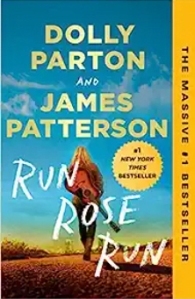 There’s a scene in the Dolly Parton/James Patterson novel Run Rose Run when an emerging singer with a raw and powerful voice is being styled into clothes, makeup, and a hairdo prior to a publicity shot. When she sees the result, she leaves the room for a few minutes only to return wearing her comfortable clothes, minimal makeup, and her hair simply brushed out into its natural way of being. The stylists are shocked. She doesn’t care. Even though she looked like a diva, looking like a diva wasn’t for her. It didn’t feel right. That meant it was all wrong.
There’s a scene in the Dolly Parton/James Patterson novel Run Rose Run when an emerging singer with a raw and powerful voice is being styled into clothes, makeup, and a hairdo prior to a publicity shot. When she sees the result, she leaves the room for a few minutes only to return wearing her comfortable clothes, minimal makeup, and her hair simply brushed out into its natural way of being. The stylists are shocked. She doesn’t care. Even though she looked like a diva, looking like a diva wasn’t for her. It didn’t feel right. That meant it was all wrong.
At this point in her introduction to Nashville and the country music business, AnnieLee Keyes is still learning “how things are done.” However, she’s defiant in a lot of ways and wants her voice and her songs to carry a career in which she can ignore how things are done.
I can identify with that because, as an author, I’ve always felt my words should be what people care about, not the clothes I’m wearing. I like blue jeans and tee-shirts with a denim or a flannel “jacket” depending on the weather. If it still ran, I’d drive up to any gathering in my old Jeep Universal or possibly an ancient 3.2-liter Jaguar Sedan. The cars would never be washed or waxed and I’d look like I hadn’t either.
In the old days, Sunday afternoons were the times when people dropped by each other’s houses unannounced, and that meant that my two brothers and I had to wear church clothes until supper. What a drag. Did anyone really think that was how we dressed day to day? In fact, I kept asking why I had to wear church clothes to go to church. That’s how things are done, I was told.
The only way to live, I always thought, was to ignore “how things were done” I always liked the song “My Way” because what other way was there? But, as many have learnt, that way is a rough way to go. The thing is, cleaning up nice feels like selling out–like how I look and how I act is just being a marionette controlled by the strings of tradition.
One has to be true to himself/herself, I think, and that means not dressing up like somebody you are not just because the wedding planner or the funeral director is claustrophobically traditional.
Good luck to you, AnnieLee Keyes.
–Malcolm
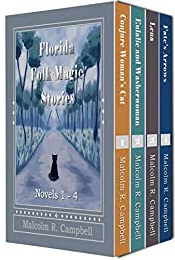 Malcolm R. Campbell is the author of the Florida Folk Magic Series which can be purchased at a savings in this four-in-one Kindle set. Folk magic means hoodoo. And hoodoo means having a weapon for fighting the KKK in 1950s Florida.
Malcolm R. Campbell is the author of the Florida Folk Magic Series which can be purchased at a savings in this four-in-one Kindle set. Folk magic means hoodoo. And hoodoo means having a weapon for fighting the KKK in 1950s Florida.
June 20, 2023
What Makes a Novel Stand Out on Submission? Susan DeFreitas on Jane Friedman’s Blog
“It has to have a sense of meaning.
“Meaning is subjective, of course. But even so, there are story elements that intersect directly with issues that we as human beings tend to find important, moving, and compelling: Moral questions, and the way they stir strong emotion. Characterization, and what it reveals about human nature. The way the story reflects the truths of our own reality—and the sense that this story actually has something to say.”
Source: What Makes a Novel Stand Out on Submission? | Jane Friedman
If a story doesn’t have more going for it than an interesting tale to tell, action-packed thought it may be, it falls flat when all is said and done. DeFreitas focuses on four major areas:
Addresses moral issues
Reflects on the truth of reality
Has complex characters
Has something to say
There may be other considerations, but an author’s consideration and implementation of each of these brings his/her story into a higher, and more interesting realm of writing than the garden-variety novel.
In terms of something so say, for example, DeFreitas writes, “What I mean is that the story is conscious of the way it uses themes to make a complex point, whether that has something to do with the importance of gritty realism over pie-in-the-sky idealism (Elizabeth Gilbert’s The Signature of All Things), the impossibility of living as a queer woman under conservative gender norms (Megan Giddings’s The Women Could Fly), or the ways that secrets corrupt us from within (Donna Tartt’s The Goldfinch).”
Needless to say (almost) is that something to say must be a solid part of the story rather than pasted into the work as an afterthought. What the story “says” has to be inseparable from the plot, theme, and characters like the air they breathe.
–Malcolm
June 19, 2023
‘Along Came a Cowgirl’ by Chris Enss
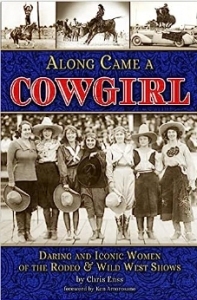 Prolific Western author Chris Enss released this book last September via Montana’s Farcountry Press. She has been writing about women of the old west for over 20 years. She’s the author of forty published books and the recipient of multiple awards for her work.
Prolific Western author Chris Enss released this book last September via Montana’s Farcountry Press. She has been writing about women of the old west for over 20 years. She’s the author of forty published books and the recipient of multiple awards for her work.
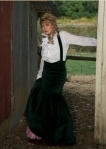 Enss
Enss
“In Along Came a Cowgirl: Daring and Iconic Women of the Rodeos and Wild West Shows, New York Times best-selling author Chris Enss introduces readers to the world of the early rodeo – and to the stories of the women whose names resounded in rodeo arenas across the nation in the early twentieth century. These cowgirls dared to break society’s traditional roles in the male-dominated rodeo and trick-riding world. Some of the iconic cowgirls included in the book are Prairie Rose Henderson, Fox Hastings, Lucille Mulhall, and Ruth Roach. With the desire to entertain crowds and armed with grit and determination, these talented bronc riders, trick ropers, and steer wrestlers were able to saddle up and follow their dreams. Along Came a Cowgirl includes a foreword by Cowgirl magazine editor and publisher Ken Amorosano.”
Farcountry Press
 “For more than 40 years, Farcountry Press has been a leader in regional publishing, specializing in stunning photography books, fun educational books for children, adventure guidebooks, and thought-provoking history titles. Farcountry’s award-winning books celebrate our nation’s cities, states, and national parks, and explore our shared heritage.
“For more than 40 years, Farcountry Press has been a leader in regional publishing, specializing in stunning photography books, fun educational books for children, adventure guidebooks, and thought-provoking history titles. Farcountry’s award-winning books celebrate our nation’s cities, states, and national parks, and explore our shared heritage.
“Farcountry publishes more than 50 books annually; the backlist has grown to more than 300 titles.”
I follow Farcountry Press because I like Montana and other western states’ history. I’m never disappointed.
–Malcolm
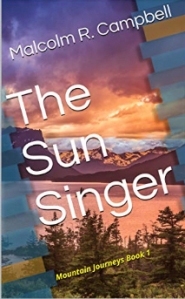 Malcolm R. Campbell’s two contemporary fantasies, “The Sun Singer” and “Sarabande” are set in Montana where he is a long-time member of the Montana Historical Society.
Malcolm R. Campbell’s two contemporary fantasies, “The Sun Singer” and “Sarabande” are set in Montana where he is a long-time member of the Montana Historical Society.

